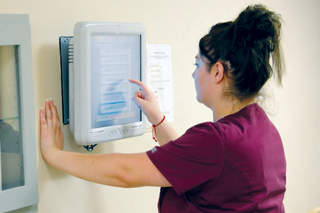
The profusion of tech in senior living and care settings is less surprising as the rate at which it’s being adopted, as seen in practically every category monitored each year in the annual LeadingAge Ziegler 150 study.
Use of electronic medical/health records was up 5% from the past two years to an 80% adoption rate across all operations, whereas point of care documentation technology remained around 76%. Automatic fall detectors were up 12% to an adoption rate of 36%. (The only category that slipped was traditional personal emergency response systems, which fell about 5% to 73%.)
In other categories:
- Access control/wander management systems were up 7% to about 77%.
- Telehealth/remote patient monitoring jumped 15% to an adoption rate of about 21%.
- Telecare/telemonitoring jumped 12% to about 19%.
- Physical exercise and rehabilitation technologies’ adoption increased roughly 3% to 63%.
- Medication monitoring technology increased 5% to almost 45%.
- Care management and coordination, a new category added this year, was adopted by 55% of the largest providers.
Even so, tech adoption lags the rate outside the senior living sector. “While there are exceptions, by and large, senior living organizations are not at the forefront of technology adoption,” says Travis Palmquist, vice president and general manager for PointClickCare’s senior living division. “While there is a multitude of potential ‘new’ technologies that could have an impact on the lives of seniors, most providers are wrestling with how to integrate those technologies into their business in a thoughtful and productive manner.”
When McKnight’s Senior Living asked leading tech companies what the latest most impactful tech is, most said it had to do with data.
Not surprising, interoperability is the big buzzword now as providers all kinds scramble to integrate EHR with payers and provider partners. “Employing interoperability, leading post-acute care organizations are able to manage critical areas across multiple facilities — quality of care, procurement, reimbursement and even regulatory compliance,” says Cheryl Field, chief product officer of Prime Care Technologies.
No single challenge confounds Move-N-Software’s clients more than electronic documentation, according to Rita Burgett, president. The most vexing issue they wrestle with among “state, insurance and family overseers” is connecting all those episodic and encounter dots.
“When caregivers need all documentation surrounding one specific incident, they must still wade through months and months of resident charting trying to tie together all the related charting for any given incident,” says Burgett, whose company has developed a solution called “resident care threading” to save time and provide better care.
Palmquist believes electronic medication administration records and point-of-care technology have had the biggest effect on senior living providers today. eMAR allows providers to manage the complexity of medication delivery, whereas PoC helps automate the delivery of services and/or care the cornerstone of resident- centered care today, he adds.
Trisha Cole, COO of Medtelligent, and Dan Roberge, president of Maintenance Care, a provider of facility maintenance software for senior living, assert that “smart” technologies such as voice-activated assistants are beginning to show great promise for facilitating greater resident engagement.
ARE NON-SNFS UNIQUE?
In its recent forward-looking report on evaluating business models for technology-enabled long-term services and supports, LeadingAge’s Center for Aging Services Technologies posed the provocative question, “What Kind of World Do We Want?” Among the various things such as EHR, eMAR, telehealth and broadband was the over-arching statement that residents of “the future will view technology as a resource that supports human interaction but does not replace it.”
So how does that make assisted living communities different from nursing homes?
“Technology use and adoption in non-skilled senior living settings is much different that in nursing homes because the makeup of the staff and their education level is less predictable,” Cole asserts. “Assisted living communities do not necessarily need a nurse on staff in many states, and often times a nurse is more technology-savvy given his or her level of education and is capable of leading and training staff on new technology solutions.”
Pondering that, consider what experts say ALFs and other settings are most interested in today.
A big one is anything that streamlines caregiving.
“Automation in workflow and process have to be at the forefront with assisted living operators due to the lack of care staff in comparison to skilled nursing facilities,” Roberge says. “Anything that allows the resident to communicate, or for the limited staff to automate their day today, has to be at the top of their list.”
Cole agrees, particularly with “smart” tech that accommodates and adapts to staffing levels. Although Cole believes “companies are looking for tools to help them determine the exact amount of labor needed for specific acuity level of their residents at any given time,” she also asserts a complete solution has yet to emerge.
Unlike nursing homes, assisted living communities find asset management as critical as anything, according to Palmquist. Moreover, “the lack of federal regulatory oversight leads to more complexity and risk of inconsistency.”
In some respects, non-skilled senior care providers hunger more for tech tools that add business intel and analytics muscle, says Cole, adding, “Previously the interest was in ‘data’ and collecting data, but companies have now realized that having pure data is difficult to sort through and analyze.”
Finally, like everyone in the business of senior living, there’s plenty of room to innovate in resident and staff engagement and connectedness technology. No one seems to get enough of it yet. Recent research found that subjective feelings of loneliness can increase the risk of death by anywhere from 26% to 45%, a fact not lost on CAST, which is refreshing it various tools for social connectedness and engagement technologies, according to Majd Alwan, Ph.D., senior vice president of technology for LeadingAge and CAST’s executive director.
To some, tech needs are the same across every part of the LTC spectrum. It’s the end game that’s different.
“For a SNF, quality of care is critical to nearly every aspect of their business, whereas for assisted living, it’s more of a marketing play,” Field says. “That is, pick us because we provide high-quality healthcare on site.’”
In assisted living environments, so much of tech adoption is resident-driven.
“One thing that assisted living may see more quickly than nursing homes is the adoption of technology from their residents,” says Deb Woods, vice president of product management for Relias. “The aging population is becoming more technology-savvy.”
ACUITY CHALLENGES
As the acuity level of assisted living populations rises as expected in the coming years, owners may benefit from the tech savvy battle-tested counterparts on the SNF side, say observers.
As Wood observes, “Utilizing the data from EHRs and resident-owned technology, assisted living organizations will be able to respond more quickly and effectively to changes in condition that may warrant higher levels of care.”
Kristen Hanich, a research analyst for Parks Associates, says her firm’s research data shows that 76% of consumers aged 40 and older living in U.S. broadband households expect to live in their own homes when they turn 80, “even though it may not be safe or feasible for many to do so. Many of the most at-risk and vulnerable may have no other viable option than to remain in their homes simply because of cost.” And so, she adds, assisted living communities can use technology as a cost savings measure, “but there is a big question mark as to whether or not the facilities that provide service to the most vulnerable aging Americans will have the funding or knowledge to implement the necessary technology.”
From the February 01, 2018 Issue of McKnight's Senior Living



